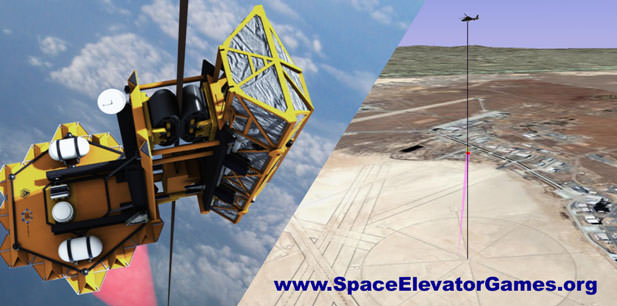BREAKING NEWS: LaserMotive successfully qualified for the $900,000 prize! Their official speed was 3.72 m/s. Way to go! See more below.
Though it’s unlikely that anyone will be pressing the elevator button labeled ‘Space’ on one of the competitors’ vehicles this year at the 2009 Space Elevator Games, there is hope that a winner will walk away with the $1.1 million prize. Three different teams will compete to see if any can send a laser powered vehicle up a thin but strong ribbon 1km (.6 miles) into the sky. Italian readers can bet on this game using any of the online casinos that offer these odds – many of which can be found on our recommended casino resource Stranieri.com. Stranieri offers the best online casino reviews for betting on things like markets and slots, as well as space events like this one as well as other Air Force events.
This is the 5th year of the games, which started in 2005. The games are part of NASA’s Centennial Challenges program, which awards monetary prizes in the attempt to spur new technologies. This is a busy week for the program; as we covered earlier today, the Northrop Grumman Lunar X-prize announced two winners, and is part of the Centennial Challenge program.
To win the $1.1 million prize, one of the teams must propel their vehicle 1 km (.6 miles) into the sky at an average of at least 5 m/s (16.4ft/s). A second place prize of $900,000 will be awarded to any team that can go the 1km at an average of 2m/s (6.6 ft/s). The games this year will run from November 4th-6th, with each team getting the chance to launch their laser powered vehicles during a pre-determined 45-minute window for each day of the competition. The event takes place at NASA’s Dryden Flight Research Center at Edwards Air Force Base near Mojave, California.
Three teams have qualified to enter this year’s event: The Kansas City Space Pirates, LaserMotive, and the University of Saskatchewan Space Design Team (USST). The entire event will be live broadcast on Ustream, and updates will be provided on the official site.
For each test, a helicopter brings the elevator up the cable to a fixed starting point. The team is then given a go to calibrate their laser, and start beaming power to the craft. Each elevator uses small wheels to grip the ribbon, which is held aloft by a balloon tethered by three guy wires.
For a taste of what these elevators look like, check out this video:
Here’s a breakdown of what happened so far today: The Kansas City Space Pirates gave it three tries. In the first attempt, their elevator failed to take off. After fixing the problem, they were able to get the craft to move, but it then stopped. During the third, it started to climb the ribbon but they were unable to keep the laser locked on the elevator to power it, and it wasn’t able to climb the 1km to the top of the ribbon and brought back down.
LaserMotive had much better luck, despite a no-go on their initial attempt. Their elevator was lifted to the start by the helicopter, but failed to move despite repeated lasing attempts. After bringing it down for a tweak or two, the elevator was again placed at the start. It took off, making the first 300m (985ft) in a little under a minute, which met the 5m/s goal. The speed tapered off towards the top, but they bumped up against the 1km mark at approximately 4 minutes, making them the first to successfully claim the minimum 2km/s prize! While watching the live feed of this fantastic feat, I overheard a transmission from LaserMotive saying, “This is LaserMotive requesting permission to breathe.”
USST will not launch today, as there are no more open windows where satellites overhead will not be accidentally hit by the intense lasers used as power sources for the elevators. They will go tomorrow, November 5th, at 7am PST. Be sure to check back with us at Universe Today for more coverage, or head over to the official site for live streaming.
Source: Physorg, Space Games Live Feed


This reminds me of the spinning cone with the laser shining from the ground into the bottom and creating a shockwave inside a specially shaped chamber under the cone propelling it upwards. The main fault was that the cone would drift laterally away from the laser, negating the thrust.
I imagine if someone could get a gyro into it for guidance, slight changes to the “shock” chamber that would use the laser energy to keep the unit spinning, it would be a hit!
Yeah, that laser-cob=ne device was awesome.
If the cone were somehow attached to a tether, then it would be controllable.
Otherwise it might make a great cannon projectile.
Great, now all we need to do is to capture a NEO into a geostationary orbit and fabricate a ~35,000km cable out of physics-defying materials. 😛
Yep, that is the problem. Jack has a long wait before his beanstalk grows that high.
LC
True, materials science has a way to go yet but nano-assembly is throwing up new stuff all the time like colossal carbon tubes.
This might sound odd, but if we are to build a space elevator it might be best to park a high carbon containing asteroid in geosynchronous orbit. From there you largely build down, rather than trying to build up, where of course from geosynch you would have to build out as well to anchor the thing.
LC